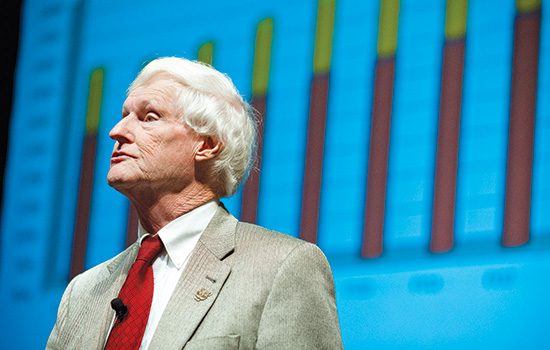Containing the cost of higher ed
A. Sue Weisler
President Bill Destler addresses the RIT community.
It’s always a good exercise to examine the family budget and see where potential cuts can be made or new thinking can be applied to strengthen your finances. At RIT, our fiscal health is very strong, but the same logic applies.
Our overall fiscal health enables us to explore new educational paradigms and possible cost-cutting and revenue-generating models from a position of strength. In the past year, we’ve asked campuswide committees to study and make recommendations to improve our operating efficiencies in areas of employee benefits, information technology, procurement of goods and services, and organization structure. Our goal is to find $3 million in the coming fiscal year by reducing administrative costs and/or increasing revenue outside of tuition increases.
Why cost-containment efforts now?
Undergraduate tuition at U.S. colleges and universities has been increasing at twice the rate of inflation for 25 years.
Last year, four-year private colleges and universities increased their tuition rates by more than 4 percent on average, yet took in less money per student on average than the year before due to discount rates.
We have reached the limit of how much more families can afford to pay for a college education, and we must try to bring our annual tuition increases down closer to the rate of inflation.
We need to protect the quality of the educational experience and the quality of student life for our students.
In recent years, RIT has done a better job of holding down tuition hikes, including a 3.8 percent increase this past year. Our goal for this fall is to keep the annual tuition increase to 3.5 percent or less. Here is a sample of some of the actions that will help us keep tuition increases closer to inflation:
- Each university vice president will find a 1 percent reduction in his or her administrative budgets.
- Dependent tuition benefits for undergraduate students enrolled at RIT will be limited to 145 semester hours per dependent. This will still ensure a reasonable amount of time to graduate.
- We will adopt an “inside RIT first” mindset in areas of food catering, printing and supplies in areas of procurement.
- Energy consumption reductions will be implemented, including the replacement of 18,000 fluorescent light bulbs with LED fixtures.
Perhaps the most controversial decision is to begin charging faculty, staff and students for parking on campus for the very first time starting on July 1. The annual fees range from $50 to $150. The costs of providing parking are real, and most of the costs of our parking operations are borne by students via tuition.Visitor parking will remain free.
The $3 million in projected savings and additional revenue will mostly be used to keep tuition increases moderate, while a portion will be used for some new initiatives.
I thought that you, members of the RIT family, should understand where we stand financially within our $666.1 million annual operating budget at a time when the university continues to be on a very positive trajectory. By numerous measures—undergraduate applications, SAT scores, student selectivity, major gifts—RIT is extremely healthy. Let’s stay fit and lean.
Cordially yours,
Bill Destler
President
P.S.: Please join me Saturday, May 4, for Imagine RIT: Innovation and Creativity Festival. Our festival is now in its sixth year, establishing itself as a community tradition. Visit rit.edu/imagine to learn more about the nearly 400 exhibits.














